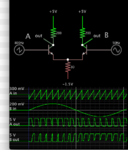Follow along with the video below to see how to install our site as a web app on your home screen.
Note: This feature may not be available in some browsers.
But its not a source its just a transistor in fact in reality
But its not a source its just a transistor in fact in reality
It is a current source although it is practically realized by transistors. BTW, the voltage sources are also most of the time made with transistors, if they are not just a battery. So, yes, the current source is a transistor that behaves as a current source. We use it in the diff pair to bias the transistors. For example, what we care for in a diff pair amplifier is mostly gm and gm depends on the dc bias current. The use of the tail current source keeps the current in the diff pair transistors independent of the input common-mode voltage, of course within some rather broad range. If we didn't have that current source and connected the sources of the input transistors directly to gnd, then the current through them will be a function of the common-mode voltage and so will be the gm. That's not what we usually want.
